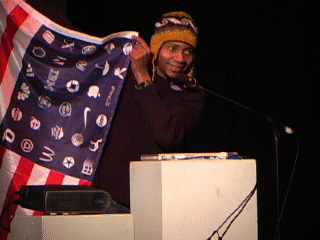"Things are always happening. It seems wherever I go there is drama. People are like lice, they get under your skin and bury themselves there. You scratch and scratch until the blood comes, but you cannot get permanently deloused ... I want the whole world to be out of whack, I want everyone to scratch himself to death. "- Henry Miller
"I'll do a mix to highlight different styles of scratching ... I have works from John Cage, Joseph Beuys, different mechanical pianos, Ornette Coleman, Miles Davis ... you'll hear them all mixed and collaged. It's always interaction- human gesture, movement, inscription ... "- DJ Spooky from the lecture "Turntablism as Performance Art "
Paul Miller, AKA DJ Spooky That Subliminal Kid, is an electronic musician and academic. I became interested in him partially because of how integrated his artistic and critical practices are: his critical writing clarifies his music and vice versa. This may be because he refined his DJing while studying critical theory at Bowdoin College, and it reflects the fact that one activity of the DJ-sampling- brings paradoxes surrounding authorship to the fore. DJ Spooky, I think, is indebted to both turntablism's roots in John Cage's project of rigorous banality (Imaginary Landscape no. 1) and to hip-hop sampling. In fact, his work suggests their overlap and ultimate indistinction.
Sampling problematizes authorship. When MF Doom constructs a beat by looping a snippet of a Steely Dan song, he uncovers expressive potentialities within the sample that were not present in its original context. When an element of a song is shown to be loop-able, reproducible, it's functionality and tonality change. DJ Spooky borrows John Cage's notion of sound as information. In the essay "Loops of Perception" , he clarifies this somewhat austere notion by quoting Don Delillo's "Cosmopolis": "In fact data itself [is] soulful and glowing, a dynamic aspect of the life process." In another novel, "Underworld," Delillo writes, "Capital burns off the nuance in a culture ... Not that people want the same things, necessarily, but that they want the same range of choices ." The sample, in DJ Spooky's hands, reduces a piece of music to a form of information that can be endlessly manipulated- "customized" - by capitalist subjectivity. What room is there for authorship in this paradigm, where a song is basically fodder for remixing?
One of DJ Spooky's better known projects is "Rebirth of a Nation," a cinematic remix of DW Griffith's 1915 silent film "The Birth of a Nation". The film portrays the antebellum south, where actors in blackface wreak havoc and are ultimately subdued by the heroic Ku Klux Klan. The film was revolutionary in terms of technique- the film is a technical masterpiece and an indispensable part of the medium's history. "The Birth of a Nation" was made possible by technological advances brought` about by the accumulation of capital. The film itself, a supposed recounting of history, effected the real world it was supposedly independent from: after it's release, there was a resurgence of Ku Klux Klan activity, the film acting as a recruitment tool. Techniques of reproduction - or converting lived experience to information- the proliferation of which is intrinsic to the growth of capital, creates necessarily this sort of hyperreal echolalia that defines modern western existence. By applying DJing techniques to the film, turning portions of the film into manipulable samples, DJ Spooky highlights their contingency. Above I asked "What room is there for authorship in this paradigm?". Rather than reinforcing the rigidity of the information age, the author (in this case, the DJ)'s artistic decisions obviate the fact that, to quote Foucault, "[things], in their substance, can change." Authorship as provocation. For DJ Spooky, who sees a world turned into information as his palette, a sample can reflect an unnerving paradigmatic contingency (for instance in his project sampling and mixing auditory, visual and statistical information regarding climate change's effects on Antarctic ice, information that documents the total instability of our mode of life), the play of sampled information emanating from DJ Spooky's turntables and projectors suggests the randomness of all information, creating an effect in the private mind of the listener that is akin to the shattering of a wineglass when a soprano belts a high C.
On the track Asphalt (Tome II) off of his record "Optometry", DJ Spooky and jazz pianist Matthew Shipp provide a stammering background for Carl Hancock Rux's smooth spoken word delivery. Rux delivers an oblique narrative about the dissolution of solidarity and artistic integrity in the hip-hop scene. The recurring phrase throughout the song is "I like it." After describing the disintegration of a scene, Rux's wry announcement of "Yeah, I like it" is sampled and repeated, becoming part of Spooky's mix. This implies, ultimately, that the eternally "current" coolness of hip-hop is indistinguishable from the vigilant boredom of Cage (see 4:33 ). By fostering an aesthetic that pursues the indistinction between the ultra-cool, live-streamed present and nowhere, DJ Spooky reminds us that, in his words, "another world is possible".


No comments:
Post a Comment